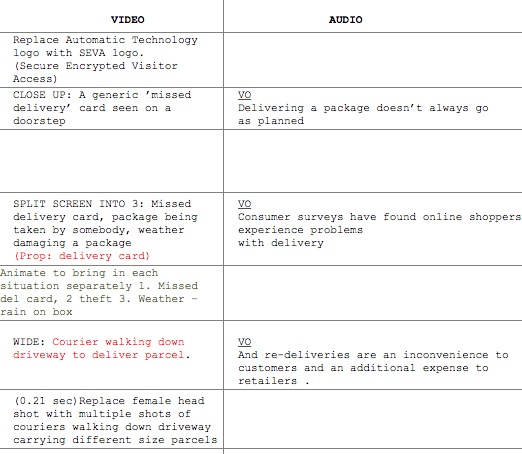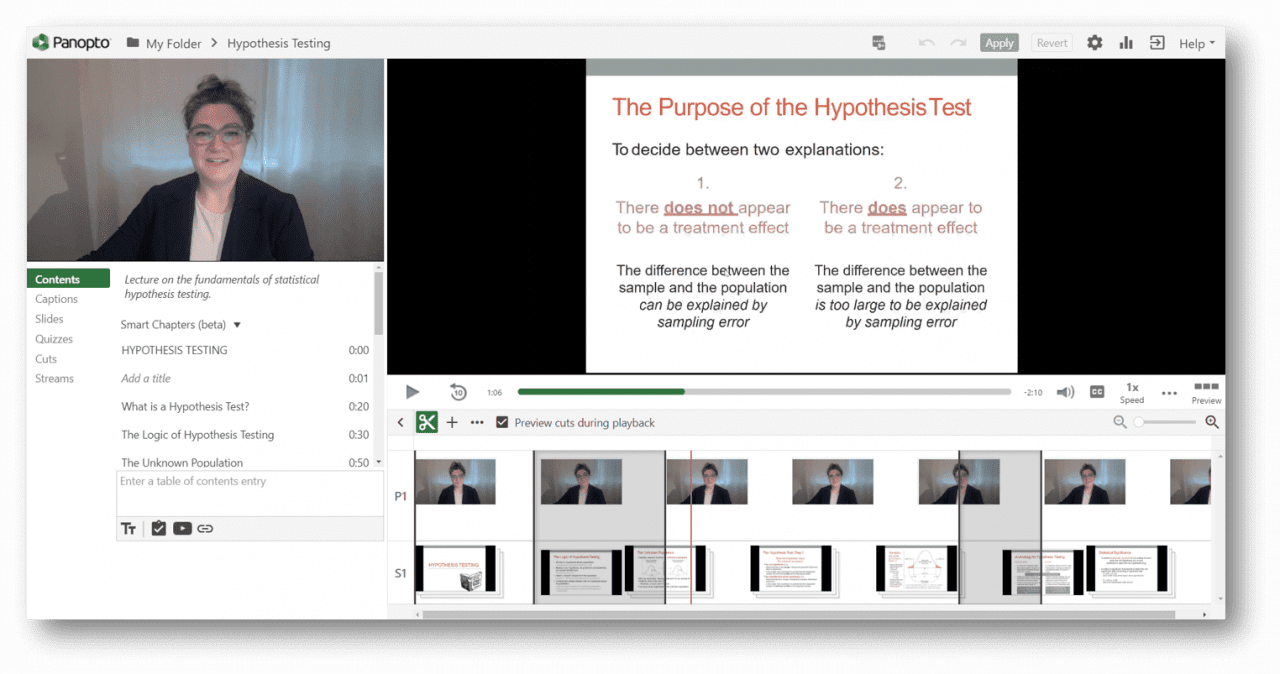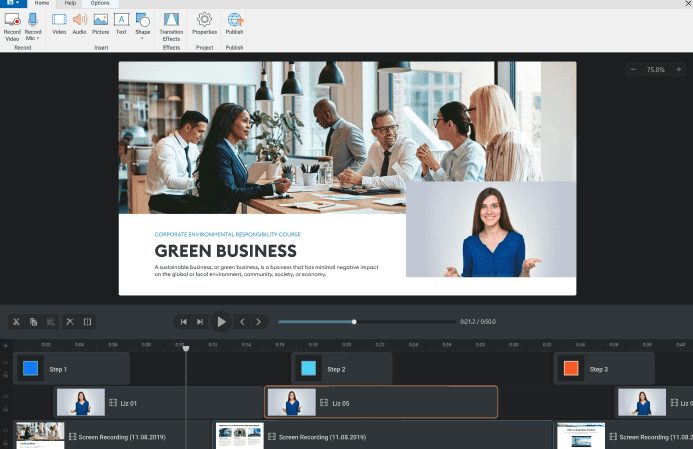Video has become one of the most promising content formats for L&D professionals today. Employees are 75% more likely to watch videos than reading process documents or blog articles.
When done correctly, employee training videos increase employee engagement and retention rates, producing more substantial ROI than long, traditional workshops. You need a clear goal, an engaging storyline, and a quality format to create training videos.
We’ve curated this list of 15 examples of training videos to help you nail all this and hit the sweet spot with your next training video – as well as why video training is a more effective medium for your L&D strategy.
Why Are Training Videos More Effective?
Video training provides benefits that text-based learning materials lack. In fact two out of three employees absorb information 7% faster and complete tasks better when instructions are provided visually. According to Google, learners are 3X times more likely to watch a YouTube video tutorial than to read a manual or instructional document for a product.
Here are a few reasons why video-based training is more effective than traditional forms.
1. Video delivers a higher training ROI
The cost of video production may seem high initially, but this one-time investment promises much better results than instructor-led training sessions (ILT). Since 51% of employees prefer self-paced training videos over ILT, you can maximize learning outcomes.
Besides, training videos cut costs in many ways. You don’t have to incur charges related to an instructor’s fees, travel, accommodation, etc. Employees can watch and learn at their own pace without losing productivity.
Microsoft’s success with video-based training over classroom training shows the ROI of training videos. The tech giant decreased its training costs from $320 per person to $17 per person in three years by picking videos over instructors.
2. It’s available to employees on-demand
Instead of asking employees to attend lengthy training sessions, videos offer an excellent alternative for self-paced learning. People can learn at their own pace and make the most of these resources.
On-demand learning boosts L&D efforts for global teams working in different time zones, perfect for the new normal. With on-demand training videos, you can effectively deliver knowledge to anyone globally. Employees can watch videos to find any company or process-related information anytime. This saves the HR team from repeating onboarding meetings, training programs, and policy conversations.
3. It increases information retention
As per the Ebbinghaus Forgetting Curve, whatever your employees learn today, they’ll forget most of it in just a week. Training videos allow them to retain learning for extended periods, inevitably improving their job performance. Pair your training videos with handy job aids, and you can set your team up for long-term success with streamlined workflows.
While watching a video, you’re not just a spectator; you are in action. Visual representations make you easily perceive and store the information in your memory longer. A study conducted by the SAVO group confirmed that presenting learning materials visually increases knowledge retention by up to 65%. This means better training effectiveness while reducing the need for continuous learning over time.
4. Video simplifies complex concepts and ideas
Videos present information in an interactive and immersive format. Good training videos hook viewers and hold their attention till the end—leading to better knowledge absorption and learning. This makes it easy to deliver complex information without creating confusion.
What’s more, videos are a versatile format of learning. You can create training videos in many styles, such as whiteboard, animation, live action, talking heads, and more. You can easily choose from various types to convey complex information as clearly as possible.
Video presentation tools provide a wide range of features and functionalities that enhance the creation and delivery of training videos. They allow presenters to incorporate dynamic visual elements, interactive elements, and professional editing techniques to make their content more engaging and impactful.
5. Video builds expertise and authority
Training videos don’t have to be limited to internal use only. Unless a video conveys confidential information, you can publish it online to present your company’s expertise on the subject. This builds credibility and positions your brand as a trustworthy resource in the industry. Doing this can increase your ROI since you can use these videos for internal and external audiences.
5 Types of Training Videos
Using videos for employee training promises better knowledge retention, improved employee performance, and higher overall L&D success.
If you’re looking for inspiration to create your training videos, we’ve compiled this list of 15 killer examples to get you started.
1. The “Welcome” Onboarding Video
Sending onboarding videos to welcome your new hires before their joining day sets the stage for employee engagement and alleviates first-day nerves.
A welcome video featuring your CEO is an effective strategy for your onboarding process that greatly impacts retention. Consider adding all the company-related information you want to showcase to your new hires, including company history, goals, culture, values – and how employees play a vital role.
These videos provide an opportunity to demonstrate your organization’s inclusive, engaging, open corporate culture that many employees seek in a company they envision staying with long-term.
2. Company Policies Video
An important part of your onboarding process is to give new hires an overview of the company policies. Video content allows you to outline complex company policies in easy-to-understand terms and in a more engaging format. Furthermore, employees can watch these videos in their own time and replay them to refresh their memory.
3. Department Overview Video
The department overview videos introduce the new hires to department goals and provide overviews of how each team supports the organization. Describing how each department contributes to the company’s overall success is a valuable way to get new hires better invested in their roles.
4. Screenshare tutorials
A software screencast is a recording of a computer screen or mobile device that is perfect for training your audience on how to use software applications, websites, or follow any process on a computer. Many simple video tutorial creation software tools are perfect for managers looking to create quick and straightforward screencasts of software how-to tutorials.
Tools like Loom allow managers and subject matter experts to record their screen, camera, and microphone – helping them record guided walkthroughs to scale onboarding for future hires, for employees to return to on-demand, or to transfer knowledge.
5. Scenario training videos
Scenario-based training is a powerful method that prompts learners with simulated scenarios to roleplay what they would do in certain situations. This engages employees in live action and enables them to learn by doing.
A video training platform lets you write your scenario scripts and easily record live enactments using any video camera. Record proper reactions and actions employees should take in certain scenarios to help employees overcome difficult situations – perfect for customer-facing teams like customer service and sales.
How to Create Training Videos for Your Employees
While video content can be intimidating, with modern L&D tools like LMS, instructional design software, and screen recording tools, video creation has never been more accessible.
You can use the following steps to guide your video training content creation journey.
1. Set goals and objectives for your training videos
Before creating your training videos, be sure to both understand your training goals, as well as your learning objectives for your employees.
- Understand your goal(s): Before creating a training video, dig into your training strategy to understand the business goal and outcomes you want to achieve. Partner with your instructional design team and review the training needs together. Understanding your training goals and objectives will help clarify the full scope of your video project.
- Define your learning objective: Define your learning objective in the sense that after watching this training video, what should employees learn or be able to do? Your learning objective should be clear, concise, and relevant. Defining a learning objective helps you provide clear instructions with achievable outcomes.
2. Create a learner profile for your audience
Ask yourself – who is this training video for? Developing a thorough understanding of your audience and their needs will guide key decisions about your videos. Take time to research and dig into the demographics to understand the education, age, professional organizations, job functions, interests, and concerns of your audience.
3. Choose your topics for your training videos
Once you have a thorough understanding of your audience, the next thing to do is select a training topic relevant to them. People easily abandon videos that don’t provide them with the information they are looking for, so selecting an exciting and important topic according to your audience is critical.
A research study by Techsmith shows that the number one reason people watch a video is because they are interested in the topic. A good practice here is to pick ONE topic per video. This narrows your scope and makes your training videos more focused and more accessible to create.
4. Select your video format and type
The next step in our checklist on how to create training videos is to choose a format for your video, whether that is an animated training video, a scenario-based video, a screen recording, etc.
All these video formats require different levels of time and effort. Consider the availability of your resources, timeline, goals, and stakeholder expectations to select the ideal video training format for your training program.
5. Create your training video script and storyboard
The most important prep task in creating training videos is to write a script or a storyboard. A storyboard is the visual representation of each shot in the video, and the script is an outline of the video audio and dialogue.
A well-written script is essential to creating an effective training video. Without a script, your videos will turn out to be confusing and disjointed. Writing a script takes practice, but here are a few tips for you to get started:
- Keep it conversational, not overly professional.
- Make it well-organized and incredibly easy-to-understand
- Cut out all the extra words and unnecessary jargon.
- Use small words that everyone understands.
- Explain what you’re doing and why you’re doing it.
- Be sure to read your script aloud before you record.
- Get feedback from teammates.
Now that you have your script set, it’s time to match the text to visual representations, that is, to create storyboards. You don’t really have to be an artist to create storyboards. Remember to keep it simple. Add some sketches or throw in images from Google’s search engine. Honestly, you don’t need to spend a lot of time creating the storyboard. Focus more on the video development process and bring ideas to life.
Scripts and storyboards go hand in hand. They help you better evaluate a video’s audio and visuals and decide what’s best for the overall objective of your training video.

6. Prepare your video equipment
When you’re ready to start creating a training video, there’s video equipment you need to acquire to ensure your video looks and sounds good. The equipment requirements depended on the video type. You may need fancy equipment like an HD video camera, lighting kit, tripod, or just a license to video animation software.
Video training software makes it easier for L&D teams to quickly produce impactful training videos for their employees. These tools help you create engaging videos without spending much money on equipment, video editing services, and other resources.
7. Record your training video
Once you are done with the prep work, it’s time to finally start recording. You don’t have to be a professional host to create a great video. Anyone can record an excellent recording or screencast with some practice. With modern HD webcams and smartphone cameras, anyone can record a training video. Be sure to dedicate an afternoon to recording multiple training videos.

8. Edit your training videos
Once you’ve recorded the footage, there are several ways to edit a video and make it visually engaging. As discussed above, there are many simple-to-use video editing software that make editing a lot less intimidating. These tools are used to manipulate and arrange video files, edit the audio, add graphics and annotations, color correct, and much more.
There are different sophistication levels of video editing software learning and development teams can leverage, from more advanced tools like Adobe Premier Pro, to basic video editing tools available through apps like Canva. There are now Gen-AI-powered video editing tools to help overcome the technical skills gap associated with editing tools.
Video editing tools come packaged with a lot of features, including:
- Custom video templates and branding options
- Embeddable quizzes and questions
- Video analytics
- LMS integrations
- Resources including motion backgrounds, animations, images, and music

9. Review the training videos with corporate stakeholders and gather feedback
Have your stakeholders or colleagues review your training video once you’ve got an early draft for your training video. Take this feedback from your teammates and use it to iterate and improve on your initial video. Feedback is the best way to ensure no mistakes and that the final product is polished.
10. Share and distribute your training videos
Once your training video is complete, it’s time to get it in front of your audience. You can post it on the company’s website, incorporate it into the monthly newsletter, or share it across social media channels.
Finally, think about where your video will live. If your videos are for an internal audience, they’ll most likely be hosted on an LMS or an internal video hosting tool. If your videos are for an external audience, many online platforms are available for hosting, such as YouTube, Vimeo, or Wistia. These video hosting tools provide various levels of analytics to track their impact.
Training Video Checklist Template
Download a customizable copy of our free training video checklist to start creating effective training videos for your employees.
19 Examples of Effective Corporate Training Videos
Using videos for employee training promises better knowledge retention, improved employee performance, and higher overall L&D success.
If you’re looking for inspiration to create your training videos, we’ve compiled this list of 19 killer examples to get you started.
1. ActiveGrowth’s Video: How to Use Loom
ActiveGrowth’s 10-minute employee training video is different from a standard training video. It’s a live-action video with contributions from multiple team members on the same topic—how to use Loom for better teamwork and fewer meetings.
The video features various ActiveGrowth employees working from their homes. It shows their take on using Loom for workplace collaboration. This detailed video shows different scenarios of how meetings can waste time and impact employee productivity. On the flip side, short Loom videos work well in many scenarios.
What makes this training video example effective?
- The video includes multiple characters and unique camera action, giving it the appeal of an engaging movie.
- The video emphasizes remote and hybrid teams’ problems with meetings and presents several use cases for asynchronous communication via Loom.
- The video draws on real-life examples to train employees for such situations and create a healthy culture of async work.
2. Gong’s Video: Objection Handling
Gong’s sales training video is a great example that can inspire your videos. Nearly 30 minutes long, this detailed training video example teaches salespeople the art of handling sales objections like a pro. This presentation video gives employees a walkthrough of the seven stages Gong follows in its B2B sales process.
The presentation includes text and visual elements to keep the video informative yet light. Since it’s a long video, a summary section at the end reinforces all the information to help viewers retain most of it.
What makes this training video example effective?
- This presentation-based video presents static content, keeping viewers’ focus on the audio and increasing learning retention.
- The video comes with a slide deck that employees can download and use as a job aid anytime they’re on an actual sales call.
- The video conveys its solutions through real-life scenarios, which makes the message more actionable.
3. Vyond’s Video: Mental Health in the Workplace
This training video from Vyond focuses on mental health in the workplace. Its an animated video that speaks directly to managers, especially those leading training remote teams. It starts with a few reasons why mental health has become an essential topic of discussion in the workplace. It goes on to highlight a few ways in which managers can support their employees.
The video presents reasonable solutions on such a critical, timely subject. Its minimalistic animation, slow music, and empathetic narration make the 2-minute video a thought-provoking watch.
What makes this training video example effective?
- The video addresses only one specific target audience (managers) and delivers relevant information for this audience.
- The voice change in the audio shows a role-play format, making it easier for managers to embrace the main message.
- While proposing several solutions, the video tells employees about the company’s mental health program.
4. PwC’s Video: Diversity and Inclusion
PwC presents a unique take on diversity and inclusion training with this concept video. It’s intended for all employees at the workplace and conveys a strong message regarding diversity.
The video uses storytelling to convey a gripping story and tell employees where they might be going wrong—intentionally or unintentionally. It also ties ethnic and racial discrimination to our cognitive capabilities and highlights how we’re wired to think a certain way. In the end, the video calls for self-reflection and the need to move beyond this way of thinking.
What makes this training video example effective?
- The video brings out the right emotions with a strong storyline and impactful sound effects.
- The message conveys new information about people’s inherent beliefs, capturing their interest until the end.
- The live-action video uses real people from diverse backgrounds to create a more realistic appeal and deliver a more substantial impact by the end.
5. Airtable’s Video: Customer Research
Airtable’s 10-minute video on using its tool for customer research is an excellent employee training video example. It’s a detailed screen recording by one of Airtable’s marketing researchers for the company’s marketing and research teams. The video follows him as he explains the process of collecting and organizing customer research on Airtable.
The video also has a sales touch since it starts with a glimpse of what customer research would look like on a spreadsheet before switching to Airtable.
What makes this training video example effective?
- The video gives viewers everything they’d need to use Airtable for customer research. It’s direct and detailed with no fluff content.
- The video wins viewers’ confidence since it’s coming from a leading researcher at the company with the expertise to show them how it’s done.
- The video is neatly divided into different sections, each covering one topic, to give employees a better viewing experience.
6. Xenium HR’s Video: Giving Constructive Feedback
This short employee training video by Xenium HR targets the topic of feedback in the workplace. It focuses on anyone in a leadership or managerial role where they’re required to share feedback with their colleagues. The live-action video uses the role-play technique to show exactly what constructive feedback looks like in action. It’s a short conversation between two people where each party conveys their views politely.
What makes this training video example effective?
- This video is an excellent example of role-play training employees about specific scenarios.
- Unlike presentations and animated videos, this video gives employees hands-on training on delivering constructive feedback.
- The video is under 2 minutes, so employees can watch it conveniently and learn a crucial lesson.
7. Deloitte’s Video: Customer Onboarding
Deloitte Digital Bank created this short training video for its sales and customer success teams to highlight the benefits of its product, its Digital Bank Accelerator. The video presents several customer pain points, then introduces its accelerator as a viable solution.
The second half of the video goes into the depths of the product’s functionality. It guides employees on how to operate the application. It also explains the backend technology to help sales and customer-facing teams handle objections effectively.
What makes this training video example effective?
- The collection of short video clips and overlay text highlighting the main details minimizes distraction and keeps the focus on the main message.
- The background narrative in a human voice adds a personal touch, making it easier for employees to pay attention.
- The video follows a clear storyline—it touches upon the challenges, introduces a solution, elaborates on the solution, and ends with a CTA.
8. Winning by Design’s Video: Customer Success Skills
Winning by Design’s 4-minute training video works more as a quick tutorial on scaling the customer success team. While it starts by painting a picture for the CEO or VP of Customer Success at a big organization, the primary message focuses on building a bigger and stronger CS team.
In just under 4 minutes, the video gives the company’s CS team and leaders a playbook for managing a growing clientele. The video covers broader ground by sharing advice on building inter-departmental collaboration with the marketing and sales teams.
What makes this training video example effective?
- The live-action video focuses solely on the speaker without any distractions. It keeps the viewers’ attention on the speaker at all times.
- The video features hand illustrations by the speaker instead of awkward screencasts or distracting overlays. This adds a dash of personalization to it.
- The speaker doesn’t beat around the bush and jumps straight to the action points, making the video more value-packed.
9. AMAZE Org’s Video: What Is Sexual Harassment
AMAZE Org designed this 2-minute employee training video to create awareness on a heavy topic, sexual harassment. Any organization or group can use this video to give employees a primer on what constitutes an act of sexual harassment and the best ways to address it. The animated video uses fictitious characters to show gestures and actions considered harassment.
What makes this training video example effective?
- The animation in the video demonstrates actions that might come under the radar of sexual harassment within or outside the workplace.
- The video offers helpful advice on how to deal with the situation if you’re a victim of harassment.
- The audio track matches the video’s style and conveys the message even with merging sounds of a few characters.
10. MasterControl’s Video: SOPs and Work Instructions
An 18-minute video by MasterControl, this training video example is sourced from a seminar session on digitizing SOPs and work instructions. It’s a detailed resource on creating a digital library of SOPs and work instructions—covering key points like why you need such a library, how to build it, the costs involved, and how to update it consistently.
The video starts with a conversation between the two panelists. But it also references a presentation with the main talking points of the session.
What makes this training video example effective?
- The conversation between two subject matter experts makes the content more credible and valuable.
- The video transitions between a seminar and a presentation, filled with pattern interrupts to hold viewers’ attention till the end.
- The video’s design is relatively simple, with a steady camera recording and a simple slide deck to convey the information—little to no distractions.
11. Zoho’s Video: Employee Overview Walkthrough
Zoho People’s training video covers a start-to-finish tool demo from a team member’s perspective. This video is meant for the new sales and customer success team members to pitch the right features and troubleshoot any queries from the clients. This 14-minute onboarding video covers every feature to give employees a complete rundown of the tool’s capabilities and interface.
What makes this training video example effective?
- The screen recording video serves a single goal—to tell viewers how to use the employee account on Zoho People.
- Even though it’s designed for employee training, the video doubles as a helpful resource for users to self-troubleshoot any doubts.
- The video uses micro-animation to make the recorded content look more intuitive and seamless.
12. InvestorLift’s Video: Lead Management Using Zapier
A detailed employee training video by InvestorLift, this 40-minute CRM training video teaches viewers all the tips and tricks for lead management on your CRM and Zapier. This is designed for employees on the sales, customer support, and business development teams.
It’s a video recording with a small bubble showing the speaker’s face to add a human touch. The video offers extensive step-by-step instructions to automate your lead management process within CRM software via Zapier.
What makes this training video example effective?
- The video gives a start-to-finish rundown on lead management using Zapier and a CRM tool, making it a comprehensive resource.
- The speaker performs all the actions live on the screen to make the video beginner-friendly.
- This video is an ideal example of when you don’t have a big budget but want to create quality resources.
13. HSEnvolvy’s Video: Workplace Safety
HSEnvolvy’s workplace safety training video is a short film on how things can go wrong within a workplace, putting your life in danger if you don’t follow all safety rules. This video targets employees working more physically-intense jobs, such as manufacturing or logistics.
The video features excellent cinematography to keep the focus on workplace accidents. Paired with high-quality audio, it conveys the importance of meeting safety instructions at all times.
What makes this training video example effective?
- The video captures viewers’ attention from the start and keeps them hooked till the end with its outstanding cinematography.
- The video’s storytelling and narrative build suspense until the end, when everything falls into place.
- The video shows dramatic action—like a movie—to depict how employees can risk their lives by not following safety rules.
14.Canity’s Video: Customer Service
Canity uses a short 1.5-minute video to inform viewers about the best ways to deal with angry and upset customers. As a part of the company’s longer series on customer service training, this animated video is engaging and shares valuable insights for customer success employees.
The video follows the main narrative and a few examples showing how these tips work in real life. In essence, it’s crisp and punchy enough for viewers to bookmark it for the future.
What makes this training video example effective?
- The animations make the video interactive and exciting compared to the standard employee training videos.
- Employees can use this short video for on-demand learning when dealing with an angry customer.
- The real-life examples in the video make it more actionable and helpful for all viewers.
15. SEO Frank’s Video: SEO Audit
SEO Frank’s 50-minute-long training video gives you a deep dive into the process of conducting an SEO audit. It’s an exhaustive screen-recorded video covering a 17-point checklist of things to do for a successful SEO audit. The speaker walks you through every item in this checklist with a stepwise breakdown of performing all the tasks.
What makes this training video example effective?
- The video is pretty comprehensive and covers everything you’d need to know about an SEO audit.
- The speaker starts every task from scratch and covers specific details about using particular features within a tool.
- The video also includes real-life examples of an audit report and how you can interpret it.
16. Google interns’ first week video
Google’s “Interns’ first-week” video incorporates different clips from interns sharing their perspectives on Google’s company culture. The video gives you a good look at its offices and surroundings. The interns speak to you directly about the company’s work-life balance and creativity in the workplace. This video serves as an excellent intro to what it’s like to be an employee at Google and makes you want to be a part of its awesome culture.
The takeaway: Infusing your video with specifics about your company culture coming directly from employees (in this example, interns) makes the onboarding process more natural for new employees who feel overwhelmed by the magnitude of the company.
17. GrubHub’s new driver onboarding video
To help out nervous recruits, Grubhub made a training video of a fellow driver walking them through his deliveries and sharing his tips and tricks. The video is very informational and highlights a list of standard operating procedures that help ensure a smooth delivery. The video is simple, short, and discusses the insider secrets of the job – with a personal touch.
The takeaway: Incorporating a few tips and tricks for employees in the videos helps them learn more in a short time and succeed on their first day.
18. Intuit’s message from the CEO onboarding video
The Intuit new onboarding video shows their CEO, Brad Smith, talking about bringing in top talent and helping them do their best work. He further adds that every employee chooses their career path, as long as they add value to the company. This encourages them to understand they will have the opportunity to move throughout the company if their performance is high.
The takeaway: The video gives new hires a chance to establish personal connections with the founders/CEOs on their very first day – as well as provides some incentive and goals for employees to work towards.
19. HubSpot Culture video
The two basic ingredients of successful storytelling are a) an interesting story and b) telling that story in a captivating way. Hubspot used both techniques while creating its new employee video. The video takes you through the company’s complete history, introduces the team, and explains the company’s benefits and values—all in an entertaining fashion.
The takeaway: Storytelling is the key to creating a highly engaging content asset.
13 Best Video Training Software in 2024
There are many software apps available to L&D teams for creating and managing training videos. Here is the best software for creating, editing, and distributing training videos and measuring their effectiveness:
Best Tools to Edit Training Videos
1. Panopto
Panopto’s video training software is a cost-effective video training tool that includes a variety of features record, edit, and share simple training videos. With Panopto, organizations help improve overall company and role-based comprehension and knowledge retention.
Panopto allows anyone to record their screen and audio, make quick video and audio edits, and add simple text overlays over the screen. It also houses all training videos in a dashboard with simple sharing features.
It instantly transforms training videos into just-in-time learning resources, indexing every video using speech and text recognition.
Key Features of Panopto:
- Instantly transform training videos into just-in-time learning resources, indexing every video using speech recognition and text recognition.
- Smart Chapters automatically creates a table of contents and a visual index for all training videos, offering employees more information at a glance.
- Add questions and quizzes in videos to make training content engaging.
- Editing in Panopto is non-destructive which allows you to always have the original recording to revert to even after all the edits.
- Video analytics allow tracking engagement, completion rates, and more.
- Live training sessions reach hundreds or thousands of employees with just a few clicks.
2. Camtasia
Camtasia is a great video training software for beginners to create high-quality interactive learning video sessions. You can record anything on the screen, and by giving a professional editor touch, upload it on any online video-sharing platform for users to access easily.
Key Features of Camtasia:
- To enhance the video’s course, the user can add animations, sound effects, music of choice, annotations, and transitions between videos.
- Add interactive quizzes directly to the video.
- Import high-definition images, audio files, and video clips of up to 4K resolution.
- Green-screen editing option allows users to switch the green background with any image/video they want in their video.
3. iMovie
iMovie is video editing software that meets the needs of a professional editor but might not be the best option for an amateur. It includes excellent tools for media organizations, color grading, speed, narration, and a soundtrack for videos but is only available for Mac users.
Remember that iMovie is a pure video editing and publishing tool – and doesn’t come equipped with training-centric features that many of the other video tools on this list have.
Key Features of iMovie:
- Start editing on iPhone or iPad, then finish on your Mac.
Built-in effects and themes.
Choose from 13 creative video filters to add a cinematic touch.
80 smart soundtracks on iOS that intelligently adjust to match the length of a movie.
Movies can be shared with family and friends through AirDrop, iCloud, social media, and video sharing channels.
4. Biteable
Biteable has 1000+ templates that allow you to craft engaging videos that fit your organization’s training goals. You do not need a technical background to create educational videos with Biteable. All you need to do is select the right template, customize the text, and add effects, and your audience is ready to engage with your lessons.
Key Features of Biteable:
- Supercharge the training videos with AI-powered voiceovers, 17.7M Shutterstock clips, and more.
- A library of over 1.8 million stock clips and images helps the creator to build training videos with that extra oomph.
- Biteable training videos are purposefully bite-sized to make the content more digestible.
- The platform allows teams to collaborate and edit videos across projects using a centralized dashboard.
5. Wideo
Wideo is an online animated video platform primarily targeted at businesses that allow users to easily create videos using more than 80 ready-made templates. Instead of starting projects from scratch, users can use the ready-made templates and create animations within minutes. The software is suitable for individuals who do not have prior experience in creating video animations.
6. Canva
Canva is an all-in-one visual design and video editing tool for non-design professionals. It’s a large repository of templates, and stock videos allow training leaders to quickly create effective training videos via a drag-and-drop editor. Export your training videos into any video file type or upload directly to YouTube or other video hosting platforms.
7. Movavi
Movavi is a video editing tools that is available for both Mac and Windows devices. The tool is a more traditional video editing tool, meaning it is not equipped with employee training features or templates – but for anyone with a bit of video editing experience, the tool is a great choice for creating employee training videos.
Best Tools for Creating Screen Recordings and Guided Tutorials
1. Whatfix
Whatfix is a digital adoption platform that allows organizations to create interactive tutorials and walkthroughs for employee training and onboarding.
Whatfix isn’t a traditional training video software tool—i.e., you can’t use the platform to record and edit videos—but it provides additional features that empower L&D teams to create interactive learning content, with in-app guidance such as step-by-step flows, smart tips, and nudges.
Flows can be created to provide in-app guidance for employees to effortlessly navigate through different processes within the enterprise applications used in their roles. These flows are then converted to video format and uploaded and embedded directly in the app for users to refer to any time they are unable to complete a process.
Whatfix also allows companies to create pop-up videos to overlay on employees’ screens at various times, from onboarding and reskilling programs to launching new software.
Anytime a new in-app learning flow is created, L&D teams can automatically export these flows into GIFs, videos, PDFs, and more – allowing learners to learn how they learn best on their own time.

2. Loom
Loom in a Google Chromme browser app that lets users quickly record their screen, camera, and microphone. This allows L&D leaders and managers to quickly create guided tutorials and walk employees step-by-step through processes. Employees can return to these videos at any time, allowing training to scale and knowledge to transfer. Loom provides easy link sharing, video organization via folders, AI-generated transcripts, and quick editing features.
3. Screencast-o-matic
Screencast-o-matic is an online tool that provides fast, free and instant recording of anything on your screen – allowing you to quickly export and publish those screen recordings into full-fledged training videos. Trainers turn to Screencast-O-Matic for easy video communication. While more a video tutorial creation software, Screen-O-Matic is ideal for creating tutorials and demonstrations on how to use software or applications.
Key Features of Screen-O-Matic:
- While recording the screen, users can record themself through a webcam at the same time.
- Include audio input and add voiceovers in videos.
- The basic version is free to use forever.
- Screencast-O-Matic enables images and video sharing on Facebook, Twitter, YouTube, and Google Drive. Paid users can publish to Dropbox, Vimeo, and other alternative video platforms.
Best Tools for Hosting Training Videos
1. YouTube
YouTube is the second most popular search engine on the web, and is a perfect place to upload, organize, and host training videos. Utilize private folders to keep corporate training videos away from the public view. Quickly share links and update video descriptions. Utilize analytics to understand training video’s reach and impact.
2. Wistia
Wistia is a simple video hosting platform for businesses. Users can quickly upload videos and organize them in a video content library using tags and folders. They can also record directly within the app and make quick edits. Embed and share videos with simple URL embedding and track usage with video analytics. It’s a great alternative to YouTube that provides powerful business video hosting features within an easy-to-use platform.
3. Lessonly
You don’t have to be a technologist to upload or embed videos with Lessonly. This full corporate LMS software’s intuitive lesson builder makes developing online training courses and content easy. Lessonly helps you produce elegant, clean lessons automatically optimized for mobile.
Key Features of Lessonly:
- Include interactive elements in the lessons like peer learning tools, quizzes, flip cards, and more.
- Combine videos with supporting text for complete and comprehensive lessons.
- The calendar alert feature ensures employees learn at the desired rate and stay on top of key lessons and assignments.
- Integrates with dozens of other tools and plays nicely with corporate LMS solutions and is SCORM compliant.
- Reporting solution allows to measure and continuously improve training content.
Empower your employees with in-app guided training and on-demand performance support with Whatfix
If your employee training efforts have produced disappointing results, training videos might turn the tables in your favor. L&D teams should also look to create next-gen training content that provides employees with contextual training and support, in the moment of need. L&D teams can do precisely that with a DAP like Whatfix.
With Whatfix, L&D teams are empowered to create in-app guidance and on-demand support content that overlays ontop of everyday applications employees use. This allows team members to receive role-personalized onboarding and training, in the flow of work. With Whatfix L&D teams can create:
- Interactive flows
- Step-by-step guidance
- Task lists
- Smart tips
- Beacons
- Embedded self-help wikis and more!
Learn more about digital adoption platforms like Whatfix now!













